engine VOLVO XC90 TWIN ENGINE HYBRID 2017 Owners Manual
[x] Cancel search | Manufacturer: VOLVO, Model Year: 2017, Model line: XC90 TWIN ENGINE HYBRID, Model: VOLVO XC90 TWIN ENGINE HYBRID 2017Pages: 584, PDF Size: 14.2 MB
Page 389 of 584
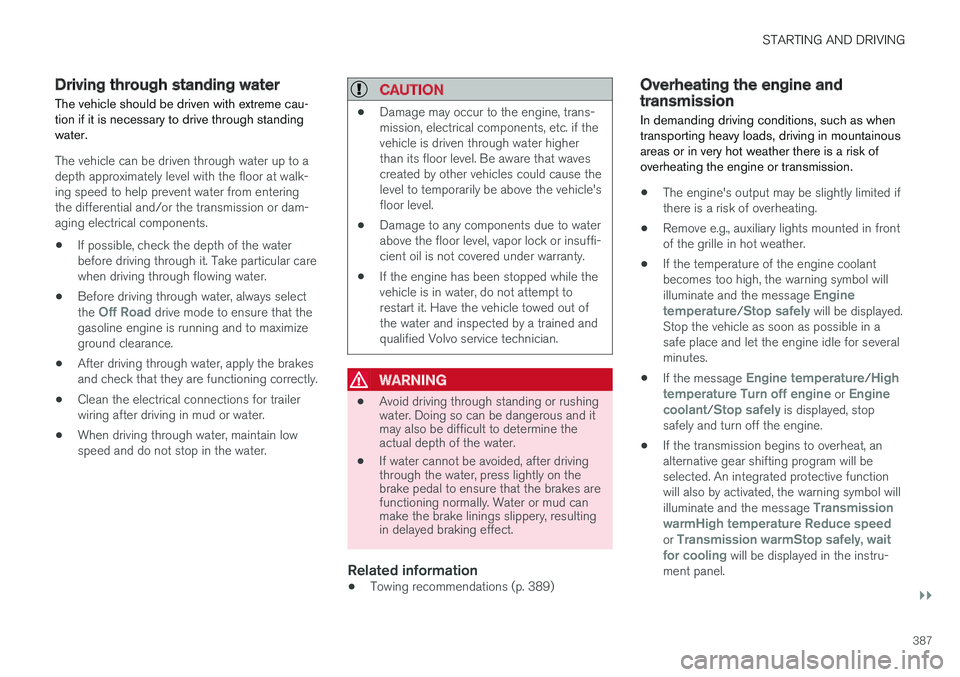
STARTING AND DRIVING
}}
387
Driving through standing water
The vehicle should be driven with extreme cau-tion if it is necessary to drive through standingwater.
The vehicle can be driven through water up to adepth approximately level with the floor at walk-ing speed to help prevent water from enteringthe differential and/or the transmission or dam-aging electrical components.
•If possible, check the depth of the waterbefore driving through it. Take particular carewhen driving through flowing water.
•Before driving through water, always selectthe Off Road drive mode to ensure that thegasoline engine is running and to maximizeground clearance.
•After driving through water, apply the brakesand check that they are functioning correctly.
•Clean the electrical connections for trailerwiring after driving in mud or water.
•When driving through water, maintain lowspeed and do not stop in the water.
CAUTION
•Damage may occur to the engine, trans-mission, electrical components, etc. if thevehicle is driven through water higherthan its floor level. Be aware that wavescreated by other vehicles could cause thelevel to temporarily be above the vehicle'sfloor level.
•Damage to any components due to waterabove the floor level, vapor lock or insuffi-cient oil is not covered under warranty.
•If the engine has been stopped while thevehicle is in water, do not attempt torestart it. Have the vehicle towed out ofthe water and inspected by a trained andqualified Volvo service technician.
WARNING
•Avoid driving through standing or rushingwater. Doing so can be dangerous and itmay also be difficult to determine theactual depth of the water.
•If water cannot be avoided, after drivingthrough the water, press lightly on thebrake pedal to ensure that the brakes arefunctioning normally. Water or mud canmake the brake linings slippery, resultingin delayed braking effect.
Related information
•Towing recommendations (p. 389)
Overheating the engine andtransmission
In demanding driving conditions, such as whentransporting heavy loads, driving in mountainousareas or in very hot weather there is a risk ofoverheating the engine or transmission.
•The engine's output may be slightly limited ifthere is a risk of overheating.
•Remove e.g., auxiliary lights mounted in frontof the grille in hot weather.
•If the temperature of the engine coolantbecomes too high, the warning symbol willilluminate and the message Enginetemperature/Stop safely will be displayed.Stop the vehicle as soon as possible in asafe place and let the engine idle for severalminutes.
•If the message Engine temperature/Hightemperature Turn off engine or Enginecoolant/Stop safely is displayed, stopsafely and turn off the engine.
•If the transmission begins to overheat, analternative gear shifting program will beselected. An integrated protective functionwill also by activated, the warning symbol willilluminate and the message TransmissionwarmHigh temperature Reduce speedor Transmission warmStop safely, waitfor cooling will be displayed in the instru-ment panel.
Page 390 of 584
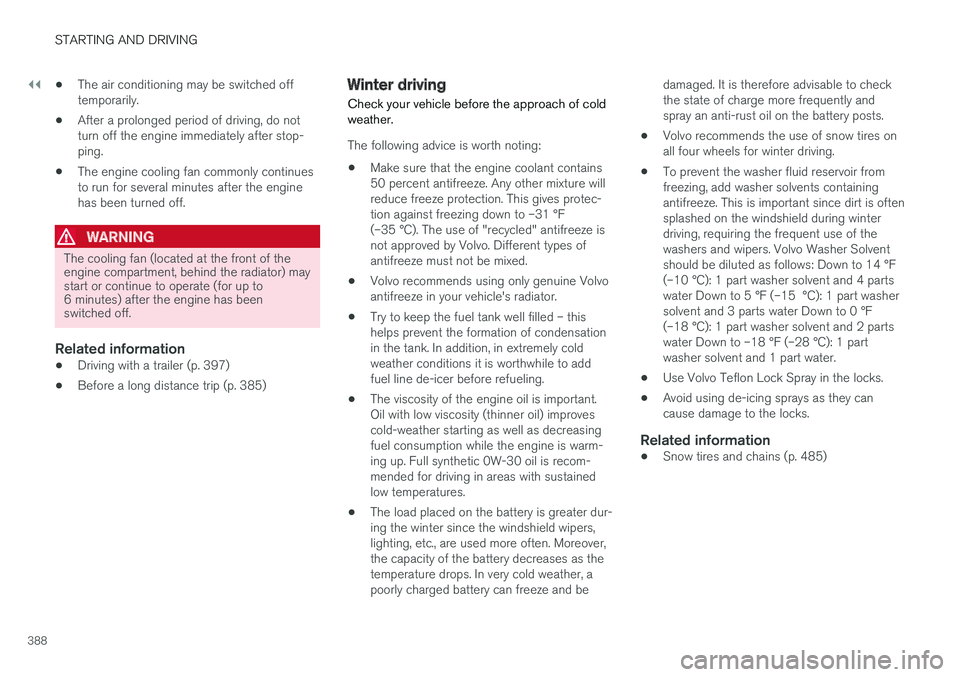
||
STARTING AND DRIVING
388
•The air conditioning may be switched offtemporarily.
•After a prolonged period of driving, do notturn off the engine immediately after stop-ping.
•The engine cooling fan commonly continuesto run for several minutes after the enginehas been turned off.
WARNING
The cooling fan (located at the front of theengine compartment, behind the radiator) maystart or continue to operate (for up to6 minutes) after the engine has beenswitched off.
Related information
•Driving with a trailer (p. 397)
•Before a long distance trip (p. 385)
Winter driving
Check your vehicle before the approach of coldweather.
The following advice is worth noting:
•Make sure that the engine coolant contains50 percent antifreeze. Any other mixture willreduce freeze protection. This gives protec-tion against freezing down to –31 °F(–35 °C). The use of "recycled" antifreeze isnot approved by Volvo. Different types ofantifreeze must not be mixed.
•Volvo recommends using only genuine Volvoantifreeze in your vehicle's radiator.
•Try to keep the fuel tank well filled – thishelps prevent the formation of condensationin the tank. In addition, in extremely coldweather conditions it is worthwhile to addfuel line de-icer before refueling.
•The viscosity of the engine oil is important.Oil with low viscosity (thinner oil) improvescold-weather starting as well as decreasingfuel consumption while the engine is warm-ing up. Full synthetic 0W-30 oil is recom-mended for driving in areas with sustainedlow temperatures.
•The load placed on the battery is greater dur-ing the winter since the windshield wipers,lighting, etc., are used more often. Moreover,the capacity of the battery decreases as thetemperature drops. In very cold weather, apoorly charged battery can freeze and be
damaged. It is therefore advisable to checkthe state of charge more frequently andspray an anti-rust oil on the battery posts.
•Volvo recommends the use of snow tires onall four wheels for winter driving.
•To prevent the washer fluid reservoir fromfreezing, add washer solvents containingantifreeze. This is important since dirt is oftensplashed on the windshield during winterdriving, requiring the frequent use of thewashers and wipers. Volvo Washer Solventshould be diluted as follows: Down to 14 °F(–10 °C): 1 part washer solvent and 4 partswater Down to 5 °F (–15 °C): 1 part washersolvent and 3 parts water Down to 0 °F(–18 °C): 1 part washer solvent and 2 partswater Down to –18 °F (–28 °C): 1 partwasher solvent and 1 part water.
•Use Volvo Teflon Lock Spray in the locks.
•Avoid using de-icing sprays as they cancause damage to the locks.
Related information
•Snow tires and chains (p. 485)
Page 391 of 584

STARTING AND DRIVING
}}
389
Towing eyelet
When used, the towing eyelet should always besecurely attached in the openings on the rightside of the front and rear bumpers. There arecovers over these attachment points.
Using the towing eyelet
Take out the towing eyelet, which is storedunder the floor in the cargo compartment.
Remove the cover by pressing the mark witha finger and folding out the opposite side/corner with a coin, small screwdriver, etc.
>The cover turns along its center line andthen be removed.
3. Screw the towing eyelet into place, first byhand and then using the tire iron, etc. until ithas been screwed in as far as possible.
After use, the eyelet should be removed andreturned to its storage location.
Reinsert the cover into the bumper.
Related information
•Towing recommendations (p. 389)
Towing recommendations
Always check with state and local authoritiesbefore attempting to tow another vehiclebecause this type of towing is subject to regula-tions regarding maximum towing speed, lengthand type of towing device, lighting, etc.
Towing your vehicle behind another
vehicle
The XC90 T8 Twin Engine Plug-in Hybrid maynot be towed behind another vehicle. Doing sowould damage the electric motor and the three-way catalytic converter. If the vehicle cannot bedriven and must be moved, it must be lifted ontoa flat-bed tow truck.
If the XC90 T8 Twin Engine Plug-in Hybrid is totow (pull) another vehicle, select the AWD drivemode. This helps charge the hybrid battery andimproves the vehicle's road holding characteris-tics.
Page 393 of 584

STARTING AND DRIVING
391
Fuel
Volvo recommends the use of detergent gaso-line to control engine deposits.
Deposit control gasoline (detergent
additives)
Detergent gasoline is effective in keeping injec-tors and intake valves clean. Consistent use ofdeposit control gasolines will help ensure gooddrivability and fuel economy. If you are not surewhether the gasoline contains deposit controladditives, check with the service station operator.
NOTE
Volvo does not recommend the use of exter-nal fuel injector cleaning systems.
Unleaded fuel
Each Volvo has a three-way catalytic converterand must use only unleaded gasoline. U.S. andCanadian regulations require that pumps deliver-ing unleaded gasoline be labeled "UNLEADED".Only these pumps have nozzles which fit yourvehicle's filler inlet. It is unlawful to dispense lea-ded fuel into a vehicle labeled "unleaded gaso-line only". Leaded gasoline damages the three-way catalytic converter and the heated oxygensensor system. Repeated use of leaded gasolinewill lessen the effectiveness of the emission con-trol system and could result in loss of emissionwarranty coverage. State and local vehicle
inspection programs will make detection of mis-fueling easier, possibly resulting in emission testfailure for misfueled vehicles.
NOTE
Some U.S. and Canadian gasolines contain anoctane enhancing additive called methyl-cyclopentadienyl manganese tricarbonyl(MMT). If such fuels are used, your EmissionControl System performance may be affected,and the Check Engine Light (malfunctionindicator light) located on your instrumentpanel may light. If this occurs, please returnyour vehicle to a trained and qualified Volvoservice technician for service.
Gasoline containing alcohol and ethers,
"Oxygenated fuels"
Some fuel suppliers sell gasoline containing"oxygenates" which are usually alcohols orethers. In some areas, state or local laws requirethat the service pump be marked indicating useof alcohols or ethers. However, there are areas inwhich the pumps are unmarked. If you are notsure whether there is alcohol or ethers in thegasoline you buy, check with the service stationoperator. To meet seasonal air quality standards,some areas require the use of "oxygenated" fuel.
Volvo allows the use of the following "oxygen-ated" fuels; however, the octane ratings listedmust still be met.
Alcohol – Ethanol
Fuels containing up to 10% ethanol by volumemay be used. Ethanol may also be referred to asEthyl alcohol, or "Gasohol".
Ethers – MTBE: Fuels containing up to15% MTBE may be used.
Methanol
Do not use gasolines containing methanol(methyl alcohol, wood alcohol). This practice canresult in vehicle performance deterioration andcan damage critical parts in the fuel system. Suchdamage may not be covered under the NewVehicle Limited Warranty.
Related information
•Octane rating (p. 392)
•Opening/closing the fuel filler door (p. 393)
Page 394 of 584

STARTING AND DRIVING
392
Octane rating
Volvo requires premium fuel (91 octane orabove) for best performance.
Minimum octane
Sample fuel pump octane label
TOP TIER Detergent Gasoline
Volvo endorses the use of “TOP TIER DetergentGasoline” where available to help maintain engineperformance and reliability. TOP TIER DetergentGasoline meets a new standard jointly estab-lished by leading automotive manufactures tomeet the needs of today
Page 395 of 584
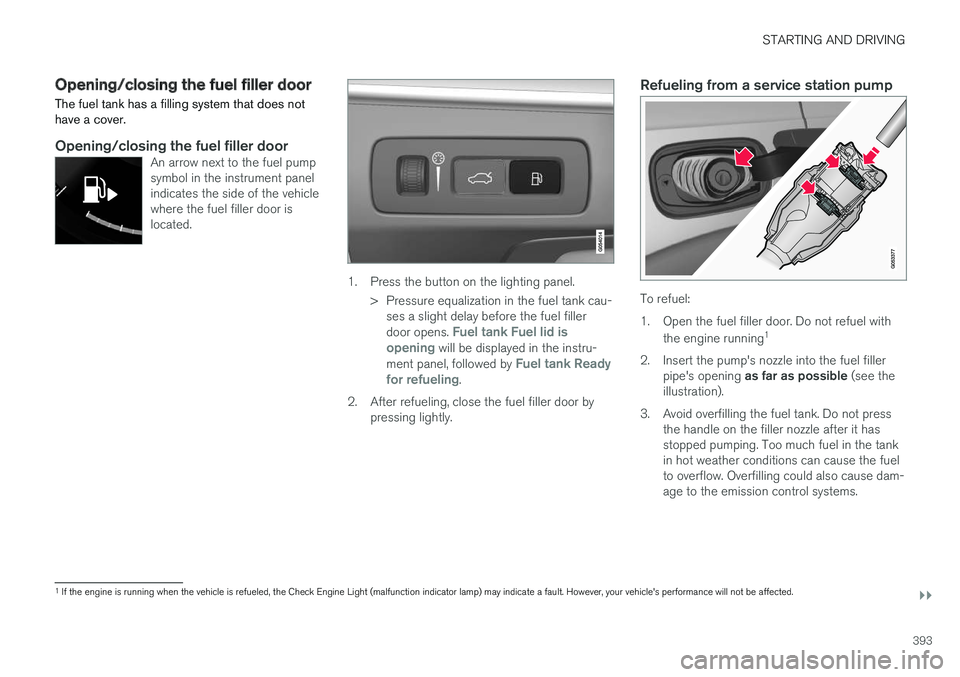
STARTING AND DRIVING
}}
393
Opening/closing the fuel filler door
The fuel tank has a filling system that does nothave a cover.
Opening/closing the fuel filler door
An arrow next to the fuel pumpsymbol in the instrument panelindicates the side of the vehiclewhere the fuel filler door islocated.
1. Press the button on the lighting panel.
>Pressure equalization in the fuel tank cau-ses a slight delay before the fuel fillerdoor opens. Fuel tank Fuel lid isopening will be displayed in the instru-ment panel, followed by Fuel tank Readyfor refueling.
2.After refueling, close the fuel filler door bypressing lightly.
Refueling from a service station pump
To refuel:
1.Open the fuel filler door. Do not refuel with
the engine running1
2. Insert the pump's nozzle into the fuel fillerpipe's opening as far as possible (see theillustration).
3. Avoid overfilling the fuel tank. Do not pressthe handle on the filler nozzle after it hasstopped pumping. Too much fuel in the tankin hot weather conditions can cause the fuelto overflow. Overfilling could also cause dam-age to the emission control systems.
1If the engine is running when the vehicle is refueled, the Check Engine Light (malfunction indicator lamp) may indicate a fault. However, your vehicle's performance will not be affected.
Page 396 of 584
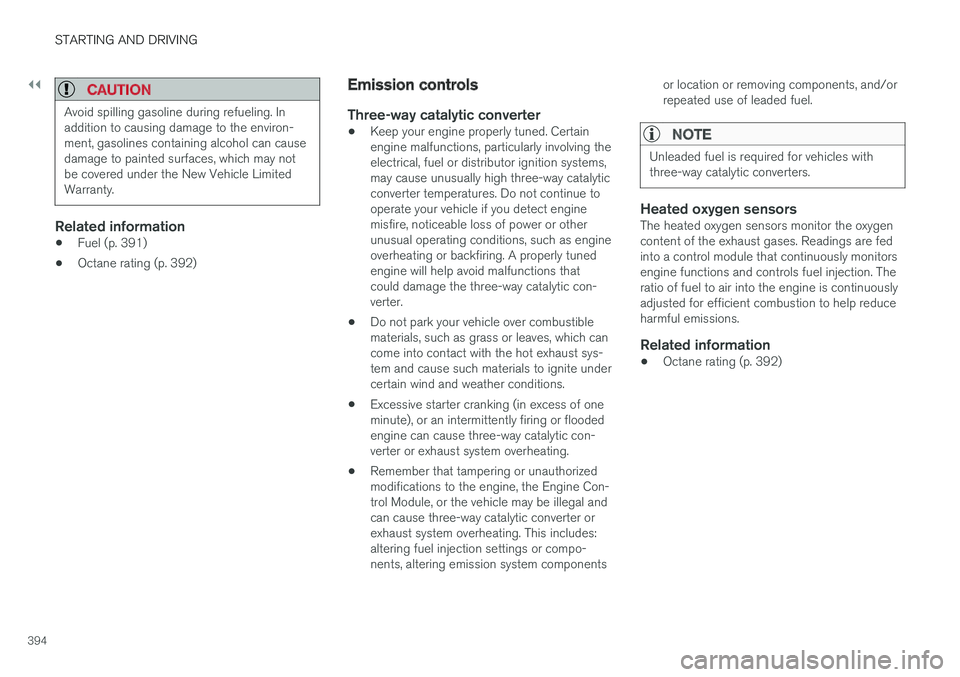
||
STARTING AND DRIVING
394
CAUTION
Avoid spilling gasoline during refueling. Inaddition to causing damage to the environ-ment, gasolines containing alcohol can causedamage to painted surfaces, which may notbe covered under the New Vehicle LimitedWarranty.
Related information
•Fuel (p. 391)
•Octane rating (p. 392)
Emission controls
Three-way catalytic converter
•Keep your engine properly tuned. Certainengine malfunctions, particularly involving theelectrical, fuel or distributor ignition systems,may cause unusually high three-way catalyticconverter temperatures. Do not continue tooperate your vehicle if you detect enginemisfire, noticeable loss of power or otherunusual operating conditions, such as engineoverheating or backfiring. A properly tunedengine will help avoid malfunctions thatcould damage the three-way catalytic con-verter.
•Do not park your vehicle over combustiblematerials, such as grass or leaves, which cancome into contact with the hot exhaust sys-tem and cause such materials to ignite undercertain wind and weather conditions.
•Excessive starter cranking (in excess of oneminute), or an intermittently firing or floodedengine can cause three-way catalytic con-verter or exhaust system overheating.
•Remember that tampering or unauthorizedmodifications to the engine, the Engine Con-trol Module, or the vehicle may be illegal andcan cause three-way catalytic converter orexhaust system overheating. This includes:altering fuel injection settings or compo-nents, altering emission system components
or location or removing components, and/orrepeated use of leaded fuel.
NOTE
Unleaded fuel is required for vehicles withthree-way catalytic converters.
Heated oxygen sensors
The heated oxygen sensors monitor the oxygencontent of the exhaust gases. Readings are fedinto a control module that continuously monitorsengine functions and controls fuel injection. Theratio of fuel to air into the engine is continuouslyadjusted for efficient combustion to help reduceharmful emissions.
Related information
•Octane rating (p. 392)
Page 397 of 584
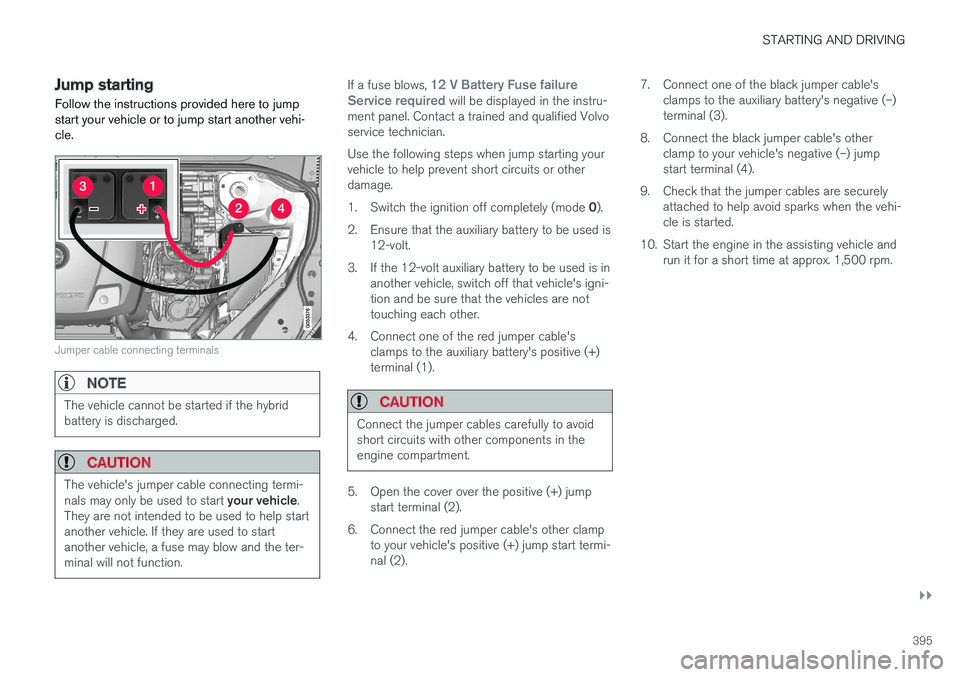
STARTING AND DRIVING
}}
395
Jump starting
Follow the instructions provided here to jumpstart your vehicle or to jump start another vehi-cle.
Jumper cable connecting terminals
NOTE
The vehicle cannot be started if the hybridbattery is discharged.
CAUTION
The vehicle's jumper cable connecting termi-nals may only be used to start your vehicle.They are not intended to be used to help startanother vehicle. If they are used to startanother vehicle, a fuse may blow and the ter-minal will not function.
If a fuse blows, 12 V Battery Fuse failureService required will be displayed in the instru-ment panel. Contact a trained and qualified Volvoservice technician.
Use the following steps when jump starting yourvehicle to help prevent short circuits or otherdamage.
1.Switch the ignition off completely (mode 0).
2.Ensure that the auxiliary battery to be used is12-volt.
3. If the 12-volt auxiliary battery to be used is inanother vehicle, switch off that vehicle's igni-tion and be sure that the vehicles are nottouching each other.
4. Connect one of the red jumper cable'sclamps to the auxiliary battery's positive (+)terminal (1).
CAUTION
Connect the jumper cables carefully to avoidshort circuits with other components in theengine compartment.
5. Open the cover over the positive (+) jumpstart terminal (2).
6.Connect the red jumper cable's other clampto your vehicle's positive (+) jump start termi-nal (2).
7. Connect one of the black jumper cable'sclamps to the auxiliary battery's negative (–)terminal (3).
8. Connect the black jumper cable's otherclamp to your vehicle's negative (–) jumpstart terminal (4).
9. Check that the jumper cables are securelyattached to help avoid sparks when the vehi-cle is started.
10. Start the engine in the assisting vehicle andrun it for a short time at approx. 1,500 rpm.
Page 398 of 584
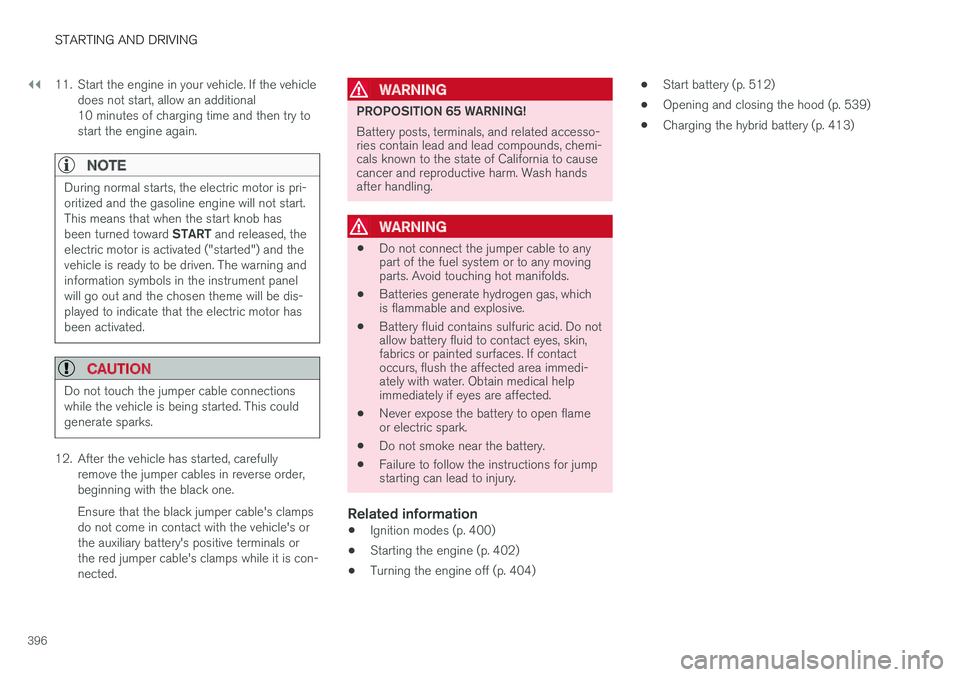
||
STARTING AND DRIVING
396
11. Start the engine in your vehicle. If the vehicledoes not start, allow an additional10 minutes of charging time and then try tostart the engine again.
NOTE
During normal starts, the electric motor is pri-oritized and the gasoline engine will not start.This means that when the start knob hasbeen turned toward START and released, theelectric motor is activated ("started") and thevehicle is ready to be driven. The warning andinformation symbols in the instrument panelwill go out and the chosen theme will be dis-played to indicate that the electric motor hasbeen activated.
CAUTION
Do not touch the jumper cable connectionswhile the vehicle is being started. This couldgenerate sparks.
12. After the vehicle has started, carefullyremove the jumper cables in reverse order,beginning with the black one.
Ensure that the black jumper cable's clampsdo not come in contact with the vehicle's orthe auxiliary battery's positive terminals orthe red jumper cable's clamps while it is con-nected.
WARNING
PROPOSITION 65 WARNING!
Battery posts, terminals, and related accesso-ries contain lead and lead compounds, chemi-cals known to the state of California to causecancer and reproductive harm. Wash handsafter handling.
WARNING
•Do not connect the jumper cable to anypart of the fuel system or to any movingparts. Avoid touching hot manifolds.
•Batteries generate hydrogen gas, whichis flammable and explosive.
•Battery fluid contains sulfuric acid. Do notallow battery fluid to contact eyes, skin,fabrics or painted surfaces. If contactoccurs, flush the affected area immedi-ately with water. Obtain medical helpimmediately if eyes are affected.
•Never expose the battery to open flameor electric spark.
•Do not smoke near the battery.
•Failure to follow the instructions for jumpstarting can lead to injury.
Related information
•Ignition modes (p. 400)
•Starting the engine (p. 402)
•Turning the engine off (p. 404)
•Start battery (p. 512)
•Opening and closing the hood (p. 539)
•Charging the hybrid battery (p. 413)
Page 399 of 584
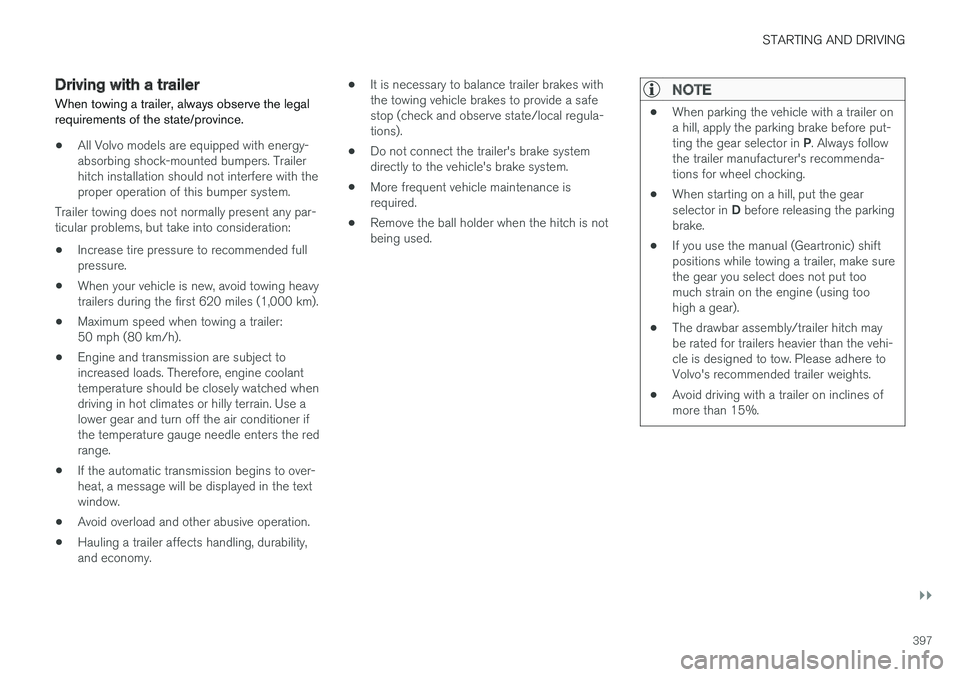
STARTING AND DRIVING
}}
397
Driving with a trailer
When towing a trailer, always observe the legalrequirements of the state/province.
•All Volvo models are equipped with energy-absorbing shock-mounted bumpers. Trailerhitch installation should not interfere with theproper operation of this bumper system.
Trailer towing does not normally present any par-ticular problems, but take into consideration:
•Increase tire pressure to recommended fullpressure.
•When your vehicle is new, avoid towing heavytrailers during the first 620 miles (1,000 km).
•Maximum speed when towing a trailer:50 mph (80 km/h).
•Engine and transmission are subject toincreased loads. Therefore, engine coolanttemperature should be closely watched whendriving in hot climates or hilly terrain. Use alower gear and turn off the air conditioner ifthe temperature gauge needle enters the redrange.
•If the automatic transmission begins to over-heat, a message will be displayed in the textwindow.
•Avoid overload and other abusive operation.
•Hauling a trailer affects handling, durability,and economy.
•It is necessary to balance trailer brakes withthe towing vehicle brakes to provide a safestop (check and observe state/local regula-tions).
•Do not connect the trailer's brake systemdirectly to the vehicle's brake system.
•More frequent vehicle maintenance isrequired.
•Remove the ball holder when the hitch is notbeing used.
NOTE
•When parking the vehicle with a trailer ona hill, apply the parking brake before put-ting the gear selector in P. Always followthe trailer manufacturer's recommenda-tions for wheel chocking.
•When starting on a hill, put the gearselector in D before releasing the parkingbrake.
•If you use the manual (Geartronic) shiftpositions while towing a trailer, make surethe gear you select does not put toomuch strain on the engine (using toohigh a gear).
•The drawbar assembly/trailer hitch maybe rated for trailers heavier than the vehi-cle is designed to tow. Please adhere toVolvo's recommended trailer weights.
•Avoid driving with a trailer on inclines ofmore than 15%.